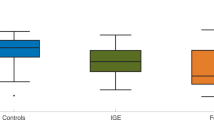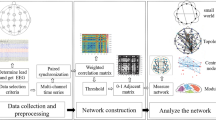Abstract
By modeling the brain as a network, the challenge of abating seizure can be recast as a problem of network control. In the premise of bringing network under control, the minimum number of nodes prerequisite for controlling seizures are thus a natural aim of interest, which is still an outstanding issue. Here, we use the network structural control theory to guide the selection for the optimal control nodes with the aim of fully abating seizures. Firstly, we construct the dynamical complex network of pathological seizure by estimating the synchronicity and directionality of information flows over time between EEG signals from 10 patients with focal epilepsy. Then, based on the controllability and observability principles of complex systems, the minimum key nodes which are effective to fully control the network seizure behaviors are obtained. Results show that the calculated control nodes are distinct with the focus zones from clinic report. This suggests that the full control of epileptic network may not only related to the focus zone, the other non-focus nodes could also play important roles. This finding is validated by using the spatiotemporal neural network model connected with our modeled dynamical adjacent matrix. It successfully reproduces the original EEG signals which can be effectively abated by applying pulse stimulation on the identified key nodes or resecting them, while the partial effects can be obtained when functioning onto the clinically identified focus zones of 60% patients. Interestingly, for another 30% patients lesser nodes than clinic reports are need to fully control seizures. In addition, our work facilitates to identify the evolution paths of information flows, so the non-clinic focus zones identified through controllability principle can be supposed to be the potential seizure foci. In sum, our work propose a general methodology or strategy for seizures focus localizations that could comprehensively consider the time-evolving information flow and the analysis of controllability mechanisms driven by the real seizures data, as well as the computational validation. This may promote to develop the canonical computational framework with the core intent of providing support for clinical treatment decisions.











Similar content being viewed by others
Data availability
The SEEG data and the Matlab code that support the findings of this study are available from the corresponding author upon reasonable request.
References
Li, F., Liang, Y., Zhang, L., et al.: Transition of brain networks from an interictal to a preictal state preceding a seizure revealed by scalp EEG network analysis. Cogn. Neurodyn. 13, 175–181 (2019)
Namazi, H., Kulish, V.V., Hussaini, J., et al.: A signal processing based analysis and prediction of seizure onset in patients with epilepsy. Oncotarget 7(1), 342 (2016)
Hussain, L.: Detecting epileptic seizure with different feature extracting strategies using robust machine learning classification techniques by applying advance parameter optimization approach. Cogn. Neurodyn. 12, 271–294 (2018)
Hejazi, M., Nasrabadi, A.M.: Prediction of epilepsy seizure from multi-channel electroencephalogram by effective connectivity analysis using Granger causality and directed transfer function methods. Cogn. Neurodyn. 13, 461–473 (2019)
Kolassa, I.T., Wienbruch, C., Neuner, F., et al.: Altered oscillatory brain dynamics after repeated traumatic stress. BMC Psychiatry 7(1), 56 (2007)
Guo, J., Biswal, B.B., Han, S., et al.: Altered dynamics of brain segregation and integration in poststroke aphasia. Hum. Brain Mapp. 40(11), 3398–3409 (2019)
Fan, D., Zheng, Y., Yang, Z., et al.: Improving control effects of absence seizures using single-pulse alternately resetting stimulation (SARS) of corticothalamic circuit. Appl. Math. Mech. 41, 1287–1302 (2020)
Yu, Y., Wang, X., Wang, Q., et al.: A review of computational modeling and deep brain stimulation: applications to Parkinson’s disease. Appl. Math. Mech. 41, 1747–1768 (2020)
Taylor, P.N., Wang, Y., Goodfellow, M., et al.: A computational study of stimulus driven epileptic seizure abatement. PLoS ONE 9, e114316 (2014)
Kramer, M.A., Truccolo, W., Eden, U.T., et al.: Human seizures self-terminate across spatial scales via a critical transition. Proc. Natl. Acad. Sci. 109, 21116 (2012)
Taylor, P.N., Thomas, J., Sinha, N., et al.: Optimal control based seizure abatement using patient derived connectivity. Front. Neurosci. 1, 202 (2015)
Nissen, I.A., Stam, C.J., Reijneveld, J.C., et al.: Identifying the epileptogenic zone in interictal resting-state MEG source-space networks. Epilepsia 58, 137 (2017)
Sakuma, S., Halliday, W.C., Nomura, R., et al.: Increased subcortical oligodendroglia-like cells in pharmacoresistant focal epilepsy in children correlate with extensive epileptogenic zones. Epilepsia 57, 203 (2016)
Chen, Z., An, Y., Zhao, B., et al.: Increased subcortical oligodendroglia-like cells in pharmacoresistant focal epilepsy in children correlate with extensive epileptogenic zones. PLoS ONE 12, e0172094 (2017)
Ma, Z., Zhou, W., Zhang, Y., et al.: Epileptogenic zone localization and seizure control in coupled neural mass models. Biol. Cybern. 109, 671 (2015)
Morrell, F., Whisler, W.W., Bleck, T.P.: Multiple subpial transection: a new approach to the surgical treatment of focal epilepsy. J. Neurosurg. 70, 231 (1989)
Iasemidis, L.D.: Epileptic seizure prediction and control. IEEE Trans. Biomed. Eng. 50(5), 549–558 (2003)
Hutchings, F., Han, C.E., Keller, S.S., et al.: Predicting surgery targets in temporal lobe epilepsy through structural connectome based simulations. PLoS Comput. Biol. 11, e1004642 (2015)
Tang, E., Ju, H., Baum, G.L., Roalf, D.R., Bassett, D.S.: Control of brain network dynamics across diverse scales of space and time. Phys. Rev. E 101(6), 062301 (2020)
Kramer, M.A., Cash, S.S.: Epilepsy as a disorder of cortical network organization. Neuroscientist 18(4), 360–372 (2012)
Palmigiano, A., Geisel, T., Wolf, F., Battaglia, D.: Flexible information routing by transient synchrony. Nat. Neurosci. 20, 1014–1022 (2017)
Battaglia, D., Witt, A., Wolf, F., Geisel, T.: Dynamic effective connectivity of inter-areal brain circuits. PLoS Comput. Biol. 8(3), e1002438 (2012)
Yang, C., Luan, G., Qian, W., Liu, Z., Zhai, F., Wang, Q.: Localization of epileptogenic zone with the correction of pathological networks. Front. Neurol. 9, 143 (2018)
Panzica, F., Varotto, G., Rotondi, F., Spreafico, R., Franceschetti, S.: Identification of the epileptogenic zone from stereo-EEG signals: a connectivity-graph theory approach. Front. Neurol. 4(4), 175 (2013)
Amiri, S., Mehvari-Habibabadi, J., Mohammadi-Mobarakeh, N., Hashemi-Fesharaki, S.S., Nazem-Zadeh, M.R.: Graph theory application with functional connectivity to distinguish left from right temporal lobe epilepsy. Epilepsy Res. 167, 106449 (2020)
Hatlestad-Hall, C., Bruna, R., Syvertsen, M.R., et al.: Source-level EEG and graph theory reveal widespread functional network alterations in focal epilepsy. Clin. Neurophysiol. (2021). https://doi.org/10.1101/2020.12.17.20248426
Brogin, J.A.F., Faber, J., Bueno, D.D.: An efficient approach to define the input stimuli to suppress epileptic seizures described by the epileptor model. J. Neural Syst. 30(11), 2050062 (2020)
Schindler, K., Elger, C.E., Lehnertz, K.: Increasing synchronization may promote seizure termination: evidence from status epilepticus. Clin. Neurophysiol. 118(9), 1955–1968 (2007)
Milton, J., Jung, P.: Brain defibrillators: synopsis, problems and future directions. In: Milton, J., Jung, P. (eds.) Epilepsy as a Dynamic Disease, pp. 341–52. Springer, Heidelberg (2003)
Le Van Quyen, M., Martinerie, J., Adam, C., et al.: Nonlinear analyses of interictal EEG map the brain interdependences in human focal epilepsy. Physica D 127, 250 (1999)
Arnhold, J., Grassberger, P., Lehnertz, K., et al.: A robust method for detecting interdependences: application to intracranially recorded EEG. Physica D 134, 419 (1999)
Mormann, F., Lehnertz, K., David, P., et al.: Mean phase coherence as a measure for phase synchronization and its application to the EEG of epilepsy patients. Physica D 144, 358 (2000)
Yang, C.Z., Luan, G.M., Wang, Q., et al.: Localization of epileptogenic zone with the correction of pathological networks. Front. Neurol. 9, 143 (2018)
Yang, C., Luan, G., Liu, Z., et al.: Dynamical analysis of epileptic characteristics based on recurrence quantification of SEEG recordings. Physica A 523(1), 507–515 (2019)
Quiroga, R.Q., Kreuz, T., Grassberger, P., et al.: Event synchronization: a simple and fast method to measure synchronicity and time delay patterns. Phys. Rev. E 66(4), 041904 (2002)
Hosseini, S.A., Akbarzadeh-T, M.R., Naghibi-Sistani, M.B.: Qualitative and quantitative evaluation of EEG signals in epileptic seizure recognition. Int. J. Intell. Syst. Appl. 5(6), 41–46 (2013)
Liu, Y.Y., Slotine, J.J., Barabasi, A.L.: Controllability of complex networks. Nature 473, 167 (2011)
Wang, W.X., Ni, X., Lai, Y.C.: Optimizing controllability of complex networks by minimum structural perturbations. Phys. Rev. E 85(2), 026115 (2012)
Slotine, J.J., Li, W.: Applied Nonlinear Control. Prentice-Hall, Hoboken (1991)
Kalman, R.E.: Mathematical description of linear dynamical systems. J. Soc. Ind. Appl. Math. Ser. 1, 152 (1963)
Luenberger, D.G.: Introduction to Dynamic Systems: Theory, Models, and Applications. Wiley, New York (1979)
Liu, Y.Y., Slotine, J.J., Barabasi, A.L.: Observability of complex systems. Proc. Nat. Acad. Sci. 110(7), 2460–2465 (2013)
Chamseddine, A., Noura, H., Ouladsine, M., et al.: Observability of complex systems: minimal cost sensor network design. IFAC Proc. 41(2), 13287–13292 (2008)
Wendling, F., Bartolomei, F., Bellanger, J.J., et al.: Epileptic fast activity can be explained by a model of impaired GABA ergic dendritic inhibition. Eur. J. Neurosci. 15(9), 1499–1508 (2002)
Liu, Y., Ma, J., Xu, Y., Jia, Y.: Electrical mode transition of hybrid neuronal model induced by external stimulus and electromagnetic induction. Int. J. Bifurcat. Chaos 29(11), 1950156 (2019)
Yao, Y., Ma, J.: Weak periodic signal detection by sine-wiener-noise-induced resonance in the fitzhugh Cnagumo neuron. Cogn. Neurodyn. 12(3), 1–7 (2018)
Wu, F., Wang, C., Jin, W., Ma, J.: Dynamical responses in a new neuron model subjected to electromagnetic induction and phase noise. Physica A 469, 81–88 (2017)
Looi, C.Y., Lim, J., Sella, F., et al.: Transcranial random noise stimulation and cognitive training to improve learning and cognition of the atypically developing brain: a pilot study. Sci. Rep. 7(1), 4633 (2017)
Terney, D., Chaieb, L., Moliadze, V., et al.: Increasing human brain excitability by transcranial high-frequency random noise stimulation. J. Neurosci. 28, 14147–14155 (2008)
Fertonani, A., Ferrari, C., Miniussi, C.: What do you feel if I apply transcranial electric stimulation? Safety, sensations and secondary induced effects. Clin. Neurophysiol. 126(11), 2181–2188 (2015)
van der Groen, O., Wenderoth, N.: Transcranial random noise stimulation of visual cortex: stochastic resonance enhances central mechanisms of perception. J. Neurosci. 36, 5289–5298 (2016)
Myers, M.H., Kozma, R.: Mesoscopic neuron population modeling of normal/epileptic brain dynamics. Cogn. Neurodyn. 12, 211–223 (2018)
Cetin, M.: Model-based robust suppression of epileptic seizures without sensory measurements. Cogn. Neurodyn. 14, 51–67 (2020)
Acknowledgements
The authors gratefully acknowledge helpful comments by the potential reviewers and acknowledge support from the National Natural Science Foundation of China (Grants Nos. 12072021, 11702018 and 11932003), the Fundamental Research Funds for the Central Universities (FRF-TP-20-013A3) and the Capital Health Research and Development of Special (2016-1-8012).
Author information
Authors and Affiliations
Corresponding author
Ethics declarations
Conflict of interest
The authors declare that they have no conflict of interest.
Ethical approval
All procedures performed in studies involving EEG data from patients who had been admitted to the hospital with refractory focal epilepsy at Sanbo Brain Hospital of Capital Medical University in Beijing. This study protocol was approved by the ethics committee of Sanbo Brain Hospital of Capital Medical University and the subject was written informed consent.
Additional information
Publisher's Note
Springer Nature remains neutral with regard to jurisdictional claims in published maps and institutional affiliations.
Rights and permissions
About this article
Cite this article
Fan, D., Yang, Z., Yang, C. et al. Clinically localized seizure focus maybe not exactly the position of abating seizures: a computational evidence. Nonlinear Dyn 105, 1773–1789 (2021). https://doi.org/10.1007/s11071-021-06676-w
Received:
Accepted:
Published:
Issue Date:
DOI: https://doi.org/10.1007/s11071-021-06676-w




